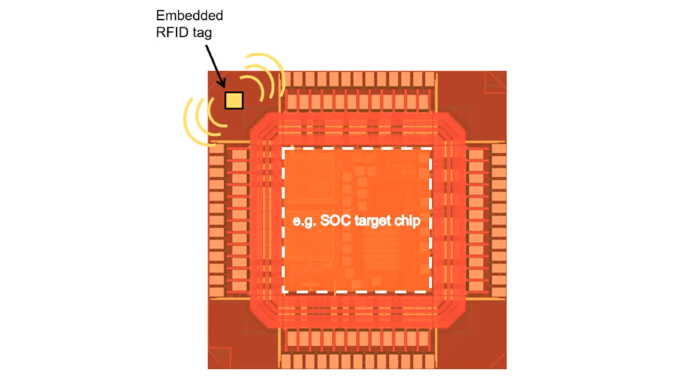Researchers at North Carolina State University have made the smallest ever state-of-the-art RFID chip, which should drive down the cost of RFID tags used in IoT applications. The design also makes it possible to embed RFID tags into high value chips, such as computer chips, boosting supply chain security for high-end technologies.
UHF RFID or RAIN RFID is an emerging IoT technology that is gaining adoption across multiple industries because its combination of low-cost tags and several-meter read range. Inventory management, asset tracking and authentication solutions are just some of the use cases being enabled by RFID in retail, logistics, supply chain, healthcare, airline baggage, automotive and manufacturing. However, many of these solutions require an optimized tag to enable long read range, leading to multifarious form factors.
“As far as we can tell, this is the world’s smallest Gen2-compatible RFID chip,” said Paul Franzon, corresponding author of a paper on the work and Cirrus Logic Distinguished Professor of Electrical and Computer Engineering at NC State. The paper was co-authored by Wenxu Zhao, who worked on the project as a Ph.D. student at NC State; and Shepherd Pitts, who worked on the project while a research assistant professor at NC State.
Gen2 RFID chips are state of the art and are already in widespread use. One of the things that sets these new RFID chips apart is their size. They measure 125 micrometers (μm) by 245μm. Manufacturers were able to make smaller RFID chips using earlier technologies, but Franzon and his collaborators have not been able to identify smaller RFID chips that are compatible with the current Gen2 technology.
“The size of an RFID tag is largely determined by the size of its antenna – not the RFID chip,” Franzon said. “But the chip is the expensive part.”
The smaller the chip, the more chips you can get from a single silicon wafer. And the more chips you can get from the silicon wafer, the less expensive they are.
“In practical terms, this means that we can manufacture RFID tags for less than one cent each if we’re manufacturing them in volume,” he said.
That makes it more feasible for manufacturers, distributors or retailers to use RFID tags to track lower-cost items. For example, the tags could be used to track all of the products in a grocery store without requiring employees to scan items individually.
“Another advantage is that the design of the circuits we used here is compatible with a wide range of semiconductor technologies, such as those used in conventional computer chips,” said Kirti Bhanushali, who worked on the project as a Ph.D. student at NC State and is first author of the paper. “This makes it possible to incorporate RFID tags into computer chips, allowing users to track individual chips throughout their life cycle. This could help to reduce counterfeiting, and allow you to verify that a component is what it says it is.”
Meanwhile, Franzon said UC was interested in working with industry partners to explore commercializing the chip in 2 ways – in the creation of low-cost RFID at scale, and for embedding RFID tags into computer chips in order to secure high-value supply chains.
#securityelectronicsandnetworks.com








